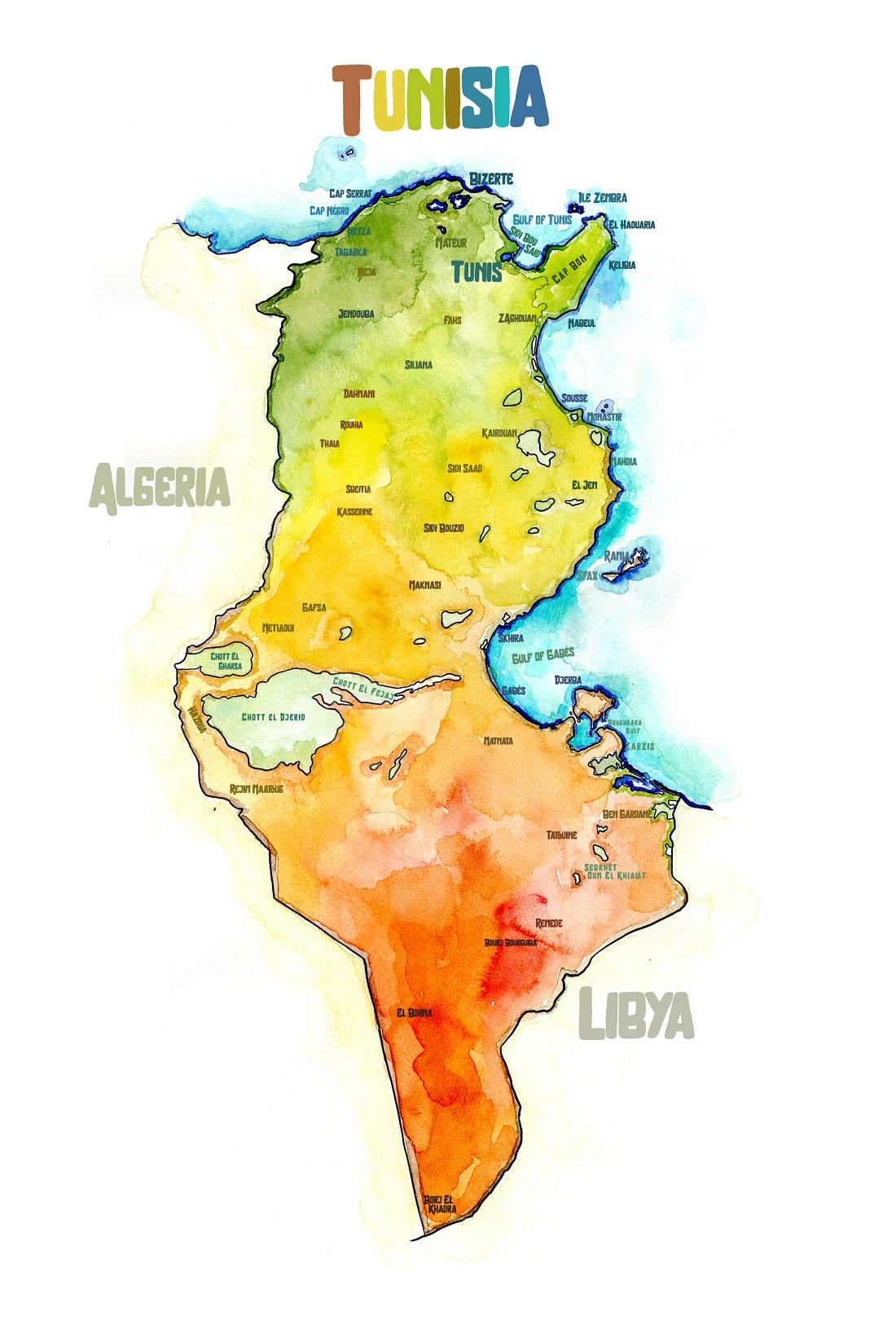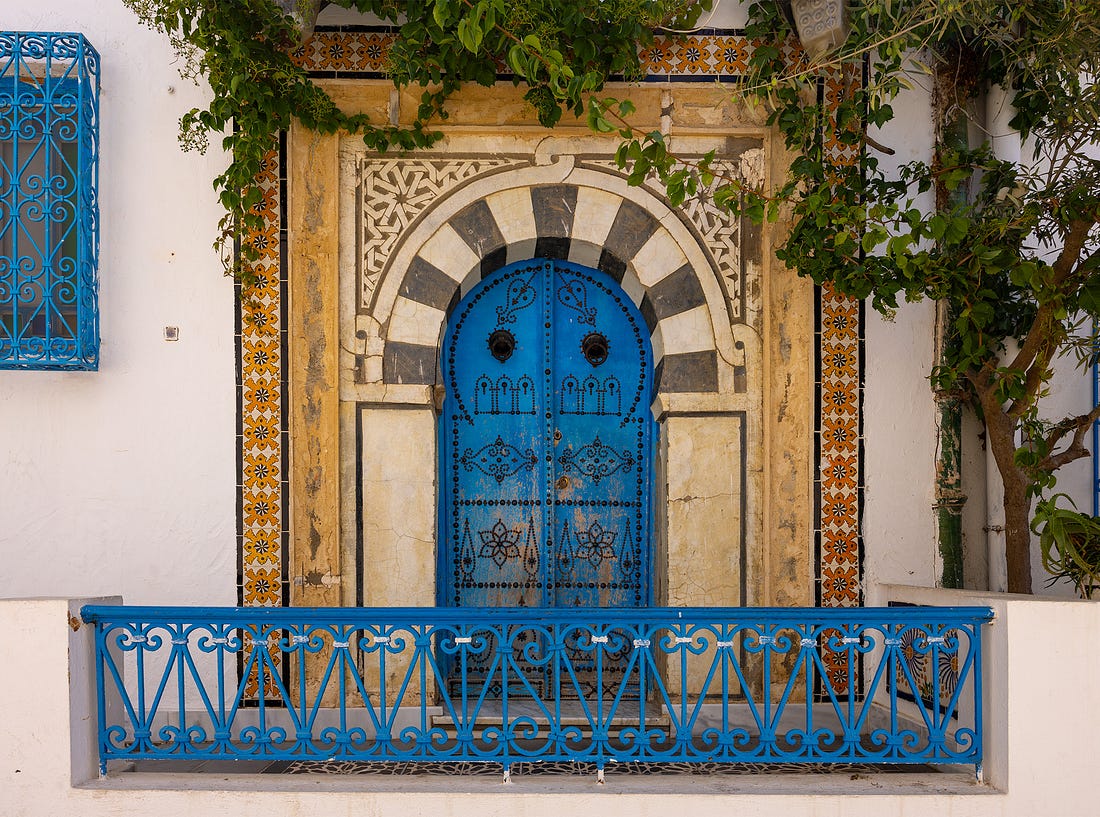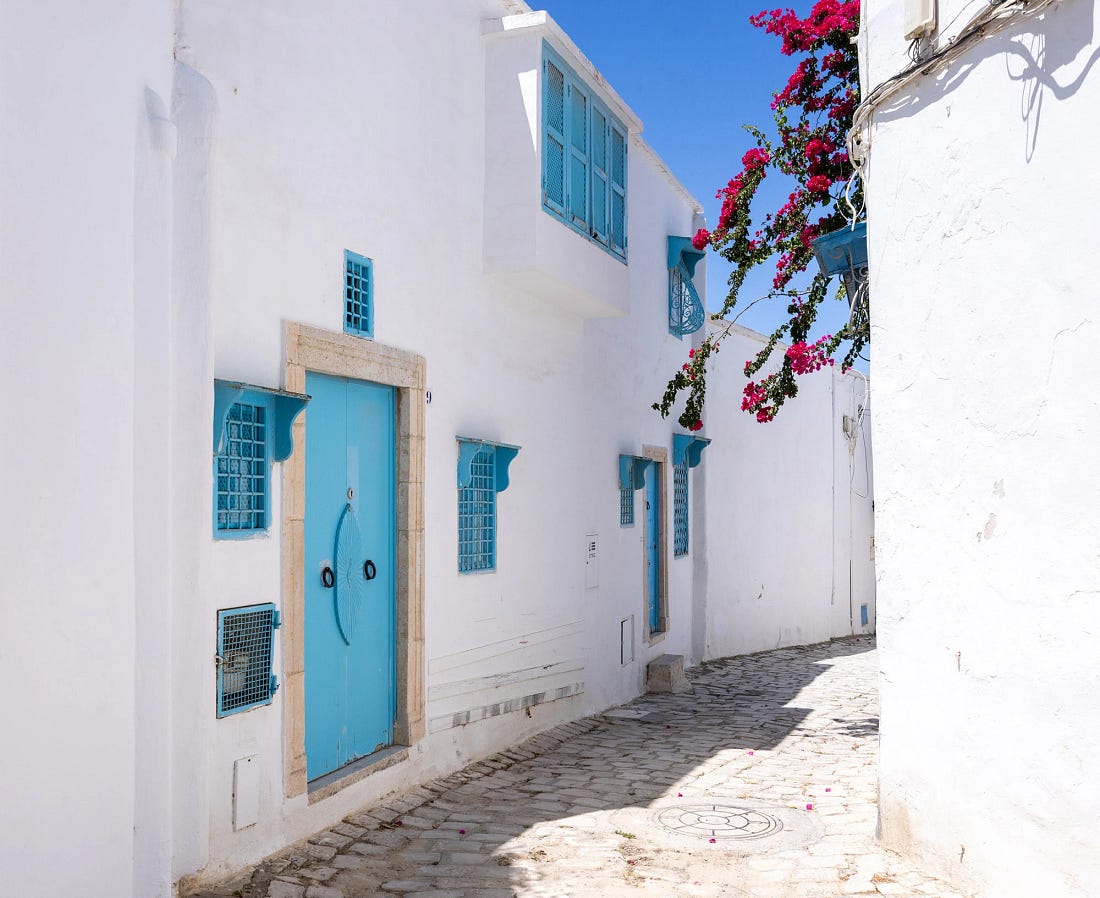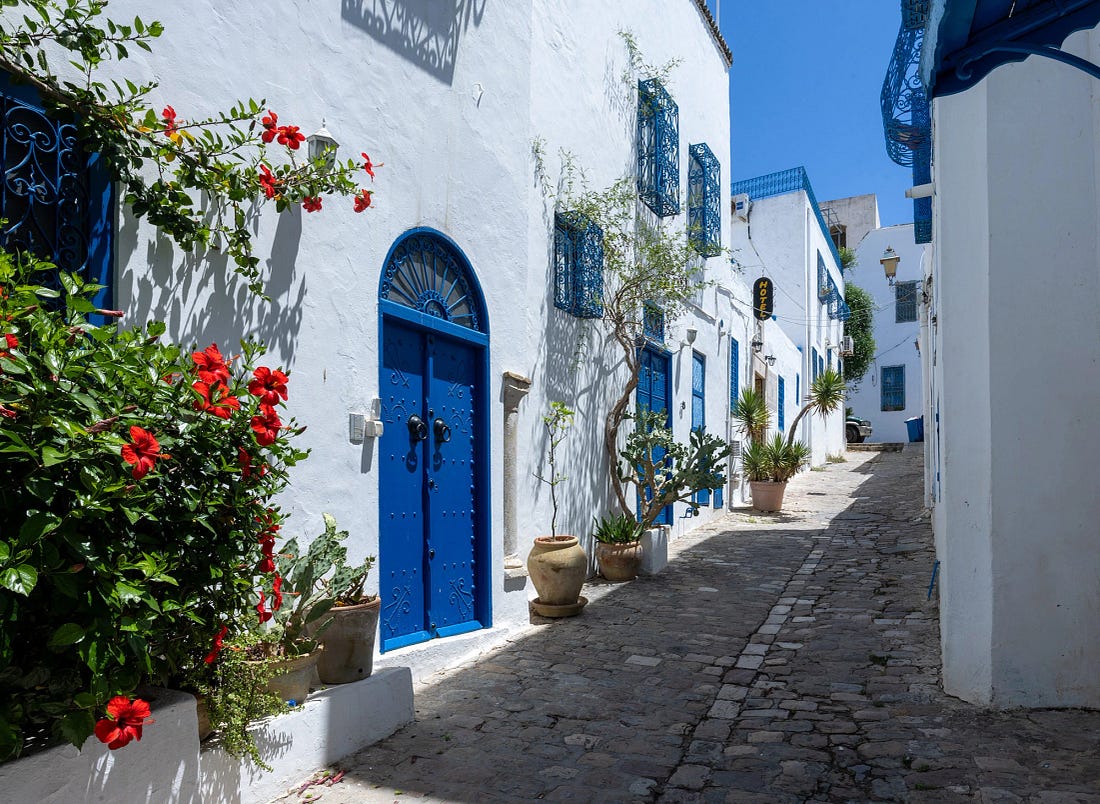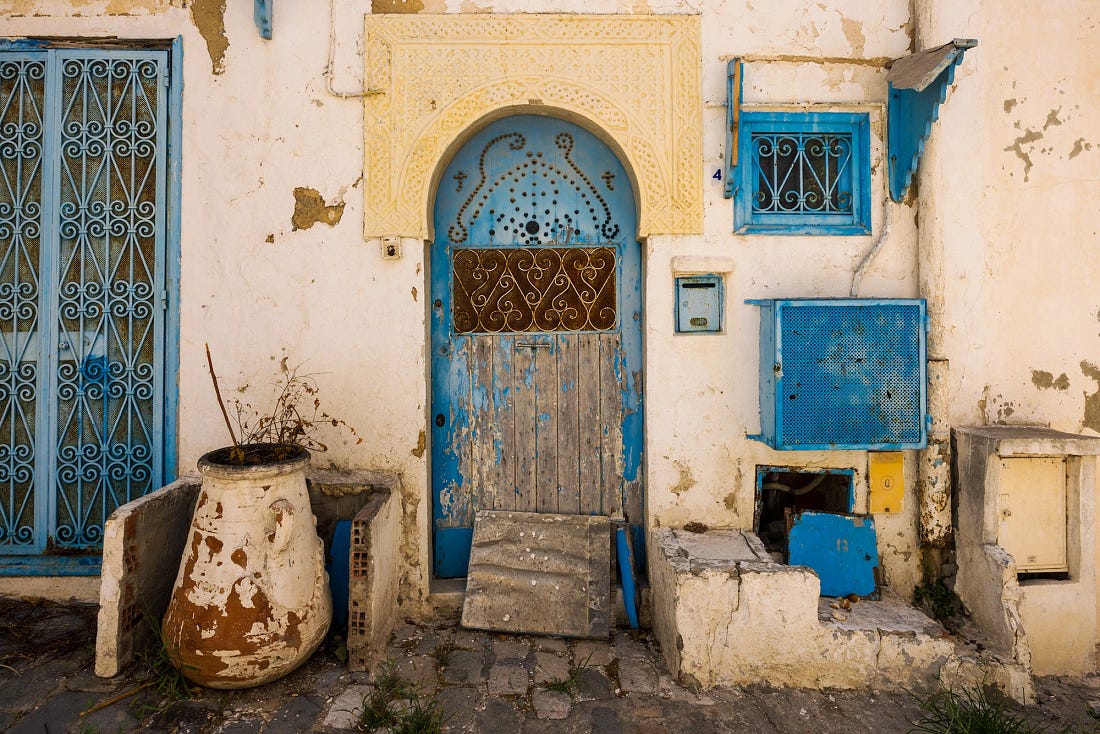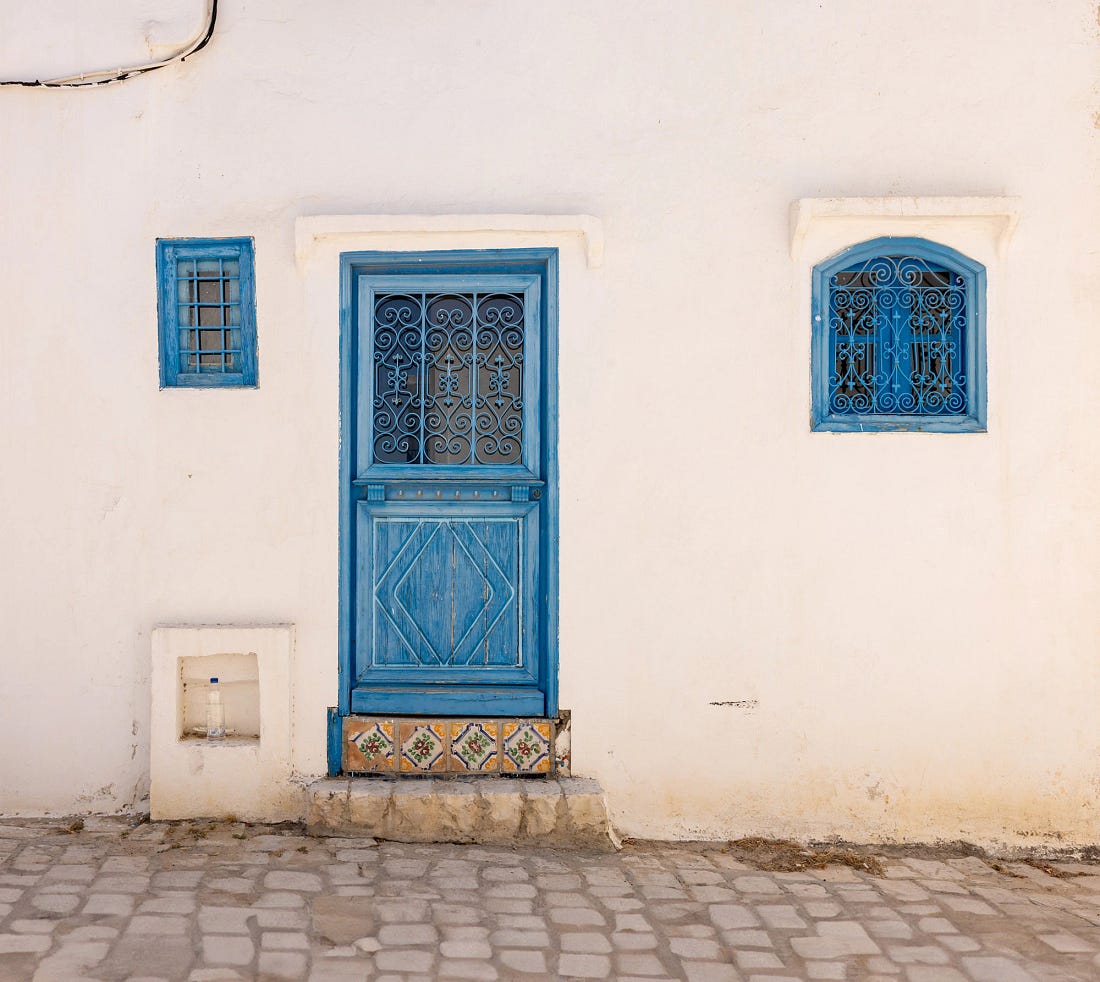A Traveler’s Notes from the Fantastical CoastIn search of the world's most fantastical coastal villages—and the human will to build them.These notes are also published on Notes from the Road, along with high resolution versions of these images. I am on my own again, with Jane and Kellan off to find ice cream, and so I leave the main road and walk into the back alleys of Sidi Bou Said, this fantastical Tunisian village on a slope that resolves into a marina and beach overlooking the Mediterranean. Sidi Bou Said is all white and blue, and at first glance it feels like a Cycladic village, with its magenta bougainvillea, oceanic light, and cobblestones. But its architectural bones are Tunisian Arabesque: heavy studded doors, horseshoe arches, courtyards, and slender minarets. I walk through narrow whitewashed streets. While throngs of summer tourists fill the main street, these back lanes are mostly quiet, save for a few neighbors sitting on doorsteps or bringing their groceries home. A single scrawny black cat walks ahead of me, glancing back with a dry, taunting meow. We pass under flowering trees and along tan cobblestones. A blue door opens, and I peek into a courtyard with seawater colored tiles. Through the doorway, I see a grandfather and young boy playing a board game in the shade. The cat disappears through the studded door. Seaside villages occupy a special place in the human imagination. They show up in children’s books, fantasy novels, and travel posters as timeless, sunlit, and half-real places. In truth, there are about 14,000 permanently settled seaside villages, towns, and cities in the world. By seaside, I mean those built directly on the ocean, not coastal places tucked back in mountains or valleys like Cuba’s Trinidad, Greece’s Lefkes, or Oregon’s Tillamook. Among them, the truly fantastical ones are rare. These are the places so impossibly aesthetic they match those children’s books. Out of those 14,000, perhaps only a hundred cross that threshold. My sense of the fantastical began early. I was a Star Wars superfan among other superfans, all of us hungry for scraps of trivia to go along with our plastic action figures. What stuck with me was learning that the architecture of Tatooine was real, filmed in a small country in North Africa. I became fascinated by the Berber troglodyte dwellings, the below-ground homes of Tunisia that doubled as Luke’s childhood home. In National Geographic photos of similar Berber dwellings, courtyards shaded by trees, rugs spread across earthen floors, organic rounded entrances resolving into warm, glowing spaces, I saw that some places could be both welcoming and timelessly otherworldly. By contrast, think about the fishing villages of New England and Atlantic Canada. They have their quaint romance with their boats, their harbors and their gulls, but their architecture is very of this world, with their dated vinyl siding, sagging dormers, and too many shutters pretending to be windows. And what about the coastal villages of Atlantic Europe? Take Port Isaac, the Cornwall setting for the British TV series Doc Martin. It is a haven of slate cottages and narrow lanes, but it stops short of dreamlike. The palette runs in grays and browns, the geometry haphazard. Travel farther east, to the seaside villages of Northeast Asia. On Ganghwa Island in South Korea, even the beloved seaside town of Dongmak Beach isn’t quite fantastical. The beach is serene and the tidal flats glow at sunset, but the architecture is sunworn and outdated: boxy pensions, corrugated seafood shacks, Day-glo signs fading in the salt air. Something changes when you reach the Mediterranean and North Africa. Here, the rare coastal settlements that cross from beauty into fantasy share an ethereal geometry of whitewashed walls rising against impossible blues and alleys that twist like music. There are only so many of these places: Oia, Fira, Folegandros’ Chora, Naoussa in the Cyclades, Positano and Manarola in mainland Italy, Cadaqués in Spain, Taormina and Cefalù in Sicily, Kotor in Montenegro, Birgu in Malta, Rovinj in Croatia, and Essaouira in Morocco. Even when overrun by summer crowds, these places retain their transcendent qualities. These are places where civilization and sea fuse into one continuous surface: real towns that look as if they belong to myth. Beyond the Mediterranean and North Africa, only a few hold up to that fantastical standard. Paraty, on Brazil’s Costa Verde, is painted in tropical colors in a unified colonial architecture. Reine in Norway’s Lofotens, Hội An’s seafront in Vietnam, and Azenhas do Mar on Portugal’s Atlantic cliffs all have their singular timeless qualities. What sets the otherworldly apart from the merely beautiful? The fantastical village does not rest in scenery alone; it is born from coherence. Every line and color hums to the same key. Light, architecture, and rhythm align in a way that makes the village feel as if the planet itself meant for it to exist. A lovely place can be stumbled upon; a fantastical one feels composed. That kind of composition does not have to be ancient or accidental. In the Pacific Northwest, the McMenamin brothers have been hinting at this for forty years. Their business empire of restored hotels, theaters, concert venues and pubs. Places like Edgefield, Kennedy School, Elks Temple, and Old St. Francis, are, at their core, experiments in world-building. They take derelict civic buildings and turn them into kaleidoscopic dreamscapes: murals that swirl with mushrooms and jazz, stained glass that glows with frontier myth, a palette drawn from Grateful Dead iconography and the 1960s. It’s psychedelic Western Americana, and rather than borrowing from other cultures, their work draws on the region that birthed it. Their spaces make you feel transported, even though you are just drinking beer in a converted classroom. If two brothers with paintbrushes and nerve can invent worlds out of brick and neon, why can’t entire villages do the same? Many of the “timeless” seaside villages we revere were deliberate acts of imagination. Sidi Bou Said’s colors and forms already existed here, drawn from centuries of Tunisian vernacular architecture: whitewashed walls for heat, cobalt doors for warding spirits, yellow accents for prosperity. Long before any foreign painter arrived, the village had developed its own grammar of architecture. When Baron Rodolphe d’Erlanger came to Tunisia in 1909, he was captivated by the white and blue colors he found on some streets in Sidi Bou Said. A Franco-British painter and musicologist perhaps most known for his role in preserving classical Arabic music, he built his palace, Ennejma Ezzahra, the “Star of Venus,” on the ridge above the village. Working with Tunisian and Moroccan craftsmen, he created a home that celebrated the design styles of the Maghreb and al-Andalus: carved stucco, latticed wood, green-tiled roofs, and patterned tiles that caught the Mediterranean sun. D’Erlanger, versed in the world of cultural preservation, used his influence to help formalize what was already there. He advocated municipal guidelines that preserved the cube-like forms, the luminous whitewash, and the continuity of blue and white from door to dome. His contribution as a preservationist was to tune an existing vision. Local builders, families, and officials continued to shape and refine those standards long after his time. The beauty that once belonged to a few streets soon defined the entire hill. The result is a village that feels composed yet utterly alive, and its a work of the twentieth century. The same pattern holds across the Aegean. The Cycladic villages of Greece, which feel as ancient as the rock beneath them, were shaped largely by twentieth-century policy and invention. Those whitewashed buildings were mandated during a 1930s public-health campaign to fight cholera. The blue trim, encouraged later for its national symbolism, became the finishing touch of myth. What began as hygiene became identity, and then legend. For every Sidi Bou Said, there are a thousand places that tried to conjure the fantastical and ended up with the architectural equivalent of processed cheese. Around the world, developers keep trying to build charm by spreadsheet, to imitate the cohesion and lyricism of the true seaside village. They all fail. Start with the gated “Mediterranean” fantasies: Porto Cervo in Sardinia, El Gouna on the Red Sea, or Dubai’s Madinat Jumeirah. These are billionaire villages, perfect stucco, no pulse. They photograph nicely from a helicopter but die the moment your feet hit the pavement. Life there exists only for consumption. The streets are too clean to belong to anyone. The architecture may echo Andalusian domes or Greek cubes, but the soul is corporate. Then there is America, whose suburbs keep trying to cosplay Europe. Seaside, Florida, the birthplace of New Urbanism and the set for The Truman Show, looks perfect until you realize its perfection is enforced by an HOA. Celebration, Disney’s own master-planned small town in Florida, rewrites nostalgia into a zoning code. Alys Beach, Florida, which is all whitewashed cubes and arched courtyards, feels like Santorini built by hedge funds. These places attempt to achieve beauty by exclusion, harmony by rulebook. They are so manicured, and their property lines so rigid, that even spontaneity seems to need a permit. Then come the gated communities, those manicured bubbles of sameness that promise safety but deliver sterility. Gates, cameras, and private security are their defining architecture. The sidewalks are empty because walking is suspicious; play is outsourced to rec centers. A true fantastical place is generated by its layers of life. It is made by children chasing cats, old couples on benches, fishmongers calling across the square. These gated neighborhoods, by contrast, are age-graded, income-graded, and silence-graded. They exclude the mix of humanity that gives a place its soul. The world is littered with even stranger experiments. China has built entire European doppelgängers: Hallstatt, Thames Town, Tianducheng—replicas so perfect they look computer-rendered and about as alive. Every window is right, and yet something is terribly wrong. And back in the U.S., suburbia keeps putting on other people’s clothes: Orange County’s Tuscan Estates, Scottsdale’s Desert Villas, Las Colinas in Texas. Terracotta roofs meet four-car garages; where fountains burble beside six-lane highways. It is a strange magic trick, importing the surface of Europe while forgetting the density, walkability, and climate that gave those forms meaning. The air conditioning runs full blast while the faux shutters remain forever closed. What all these places share is a single, fatal flaw: they mistake aesthetics for atmosphere. They build façades, not feelings. The fantastical village works because it is porous—light, sound, and life leak through it. The failed imitations wall themselves off, policing their perfection until there is nothing left to love. The wealthy are often the first to buy into such dreams, and the first to flee once they realize they have purchased sterility. Many seaside billionaire fantasy villages fail quickly as the illusion wears thin. True beauty, the kind that lasts, comes from permeability, from the meeting of difference and daily life. The fantastical should not be a luxury. It should be the baseline of a civilization that values life. A true fantastical village is not just visually coherent; it is livable, walkable, breathable, textured with human variety. The places on earth where people live the longest and happiest lives, the so-called Blue Zones, are defined by their intimacy of scale: streets narrow enough for neighbors to talk across, markets close enough to walk to, public squares that keep people mingling through the decades. The fantastical, it turns out, is good urbanism. But somewhere along the way, we forgot that beauty and livability were the same thing. The loudest champions of “traditional” architecture, especially those now pushing Trump’s edicts to bring back “classical” buildings in the United States, confuse imitation with integrity. They mistake Florida glitz for Athens and think democracy can be coated with gold leaf and columns. Their vision of grandeur is a real-estate aesthetic that worships at the altar of gaudiness. The true fantastical listens to its surroundings: its climate, its culture, and its present, as much as its past. The fantastical villages of the future will look less like symbols of empire and more like those Berber troglodyte dwellings: themselves. And like Luke’s homestead, with its underground rooms and moisture vaporators, the fantastical seaside villages of tomorrow will have solar roofs, shaded walkways, buildings that breathe, and gardens that clean their own air. The worldbuilding will be adapted to the reality of the time. They might use green roofs that double as community spaces, seawalls that double as promenades, and walls made of living materials that filter heat and salt. Narrow streets could collect rainwater for reuse; microgrids could power the lights from sun and wind. How do you turn this into the fantastical? There is no better time to ask that question, as retrofitting the world’s lived spaced will soon become existential. In these imagined near future places, transportation hums quietly on bicycles, trams, or small electric carts. Architecture blends into the terrain instead of defying it. Their ornament will be function, their aesthetic drawn from ecology rather than nostalgia. If the Cycladic whitewash was born from lime and sunlight, ours might come from algae panels and recycled glass. Now isn’t the time to borrow other people’s columns; it’s time to look under the hood locally and let each place build its own visual language from its soil, weather, and memory. We stand at an intersection where climate change, loneliness, and ugliness converge. Retrofitting our spaces can be both an aesthetic project as much as an existential one. Settlements of all kinds, from city to village, are estimated to be responsible for up to 80 percent of climate change. We must remember places like Sidi Bou Said and rediscover how to make places that pull us outside, that make walking irresistible, that teach children and elders to share the same bench, while, like Aunt Beru and Uncle Owen’s homestead, adapting to the realities of climate and place. Beauty, in the deepest sense, might be our most practical survival tool. Notes from the Road is free today. But if you enjoyed this post, you can tell Notes from the Road that their writing is valuable by pledging a future subscription. You won't be charged unless they enable payments. |


